Kirby Power Paintbrush (Nintendo DS) Review
By Mike Mason  25.09.2005
25.09.2005

Kirby, the lovable named-after-a-hoover-bag pink ball has been a main, if very overlooked, member of the great family Nintendo for over 15 years now, starring in some of their best games and some of their more painfully average jaunts (we’re looking at you, Kirby’s Air Ride...). ‘Like a rollercoaster’ would be the best way to describe his career, which certainly fits in well with his DS debut’s rainbow-based action...
HAL are well and truly back in the hot seat, relying upon nobody else for this instalment of one of their key franchises. As is tradition with the Kirby games, the story is one of such detail and suspense that George Orwell would be proud of it - Kirby goes out for a walk and suddenly a witch appears, drawing across Dream Land’s sky, turning it into some kind of giant paint pallet. The witch, Drawcia, spots Kirby and escapes through a portal in the sky. An infuriated (and surely very intimidating) Kirby gives chase and is turned into a ball for his efforts. After noticing his shameful new form, he also notices a magical paintbrush which Drawcia has dropped and it "transports to you in a ray of light". It’s no '1984', but fluffy, simple stories are expected with Kirby games and fit in well with the gameplay. We wouldn’t have it any other way.
This storyline was clearly the avenue that HAL needed to show off how well the DS can handle 2D graphics. The backdrops, looking unmistakably paint-tastic, are crisp and colourful while not interfering with the gameplay at all - this could easily qualify as Kirby’s best 2D outing, with some stunning graphics displaying a variety of areas, such as grassy fields, underwater mazes, futuristic space stations and space itself. Trademark bouncy sounds and music also accompany the story and fit in as well as ever, consisting of mixes of old Kirby songs and effects (the end of level celebration sounds thankfully remain) and new ones. If you work hard at it, you may be able to unlock some classic songs from Kirby Fun Pak (Kirby Super Star) too...
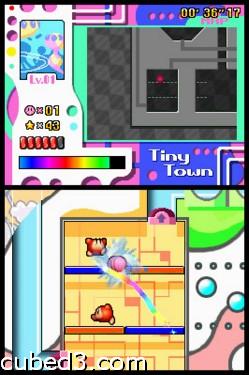
If you’ve played and enjoyed any Kirby games in the past, you’ll be right at home with the difficulty level and length of the title. Upon entering the game you are given the opportunity to partake in a brief tutorial mode to learn the basics, and after that you’re on your own to tackle the main game. The levels come in sets of stages, each with three ‘acts’; there is no relation between the acts in each stage, and you can tackle the three in any order you want. Once you’ve beaten all three acts in a stage (each ending with a mini-game where you must fire Kirby across a stretch of land as far as possible - as fun as it sounds), the next stage is opened up, with a boss battle presented at the end of each stage. In total there are seven stages, giving a total of 21 levels and a stage for the final boss in the main game - not too shabby at all. Without knowing how the game actually works, though, this knowledge is useless, is it not? Here we go...
Since Kirby currently looks like a medicine ball, he won't be doing any walking. Instead, he rolls around the levels of his own accord. In a similar vein to Yoshi Touch & Go, you do not strictly have direct control over your character's movement, aside the odd tap on him to activate a special move (the default is the very important dash, which does as it says on the tin - we’ll come back to the other special moves later). Instead, you draw rainbows (a very loose, quasi-equivalent to the clouds of the dinosaur’s game) to help the legless one get to where he wants, but this is where the similarities to Yoshi’s game end. Kirby will roll along the rainbow paths that you draw with your ‘Magical Paintbrush’, moving in the direction that you drew the path. There is no real limit to where the rainbows can be drawn, so Kirby can be launched into the sky with a nicely curving swipe, but there is a limit to how much ink can be used. A metre resides on the top screen, and when it empties the brush will need to be ‘recharged’ (well, it is magical). The ink metre will refill slowly while Kirby is airborne, but will charge up fast when he is idly lolling about on the floor. You are always able to use a smidge of ink for emergencies, but every time you do this while in the air the metre will move back down and need to charge again. Drawing simple paths is not the only thing that the paint trails can be used for, though. If you want to be a bit more daring, loop-de-loops can be drawn for Kirby to scoot through and give him a nice speed boost. Sketching vertical walls in front of Kirby is also an essential part of gameplay when the out of control blob is on the ground. Upon hitting one, he will turn and begin to roll the opposite direction. This is very handy for giving yourself a few seconds to pull yourself/your ink metre back together to complete the task at hand without having to worry about Kirby going to the great ball pit in the sky while you do so.
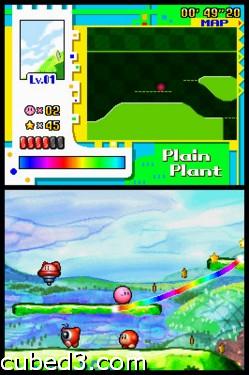
Earlier, special moves were mentioned. Now, just because Kirby has lost his potent sucking abilities, it doesn’t mean that he’s given up some of his more unethical practices - once a thief, always a thief. If you tap an enemy to stun them, Kirby can roll into them and nick off with whatever talent they happen to possess that makes them so unique in the world; to add insult to injury, after making off with their careers and giving them an early retirement, he also does away with them entirely. You can aid his sinful ways via another method as well, by tapping Kirby to make him dash into them - either way, redundancy officer Kirby can take these powers and use them as his own. A long time staple in the Kirby series, these gifts allow the puffball to advance through levels and access secret areas.
Did somebody say secrets? This is another running feature in the series. Never make the mistake of looking at a Kirby game, playing through the main game and then thinking you’re done, because there will always be more to find, as you will discover here. In this case, HAL have pushed the boat out. Upon completing the somewhat short main game (it can be taken care of in a couple of very fun days), you’re then thrown the daunting task of collecting 250 medals. These medals can be used to buy things in the shop, including different paint types for your brush, music, new levels and even hidden characters. Many of these medals can be discovered in the main game (there are three in each act), but to get them all you also have to do well in the time trial and line trial modes. In the time trials you have to make your way through certain parts of each act as quickly as possible, while in line trials time is no matter and you must get through certain parts of each act using as little ink as possible. These modes both effectively double, perhaps triple, the length of the game as they can be very challenging. There are three medals up for grabs for each time trial and line trial. Other medals are earnt by performing well in other mini-games unlocked, which double as the bosses after each stage.

Kirby: Power Paintbrush is an extremely fun game, which bestows a great deal of freedom upon the player while being very clear and stern about what it asks of you. At times you will definitely die repeatedly, particularly during the devilish seventh stage, but more often than not you will go back for more and think 'one more go', just because the rainbow mechanic is implemented so well. That's not to say that the game is without its faults - there are a few oversights that could’ve perhaps been fixed with a little more development time. For the most part, while enjoyable (especially King Dedede’s appearance), the boss battles are disappointing, playing out as mini-games rather than the true end-of-level battles they should’ve been. The only exception to this is the final boss; it says it all that this match of wits and wills is the absolute, nothing-else-tops-it highlight of the game, so it would’ve been nice to see some better face-offs against the other enemies, too. Another feature which could’ve been implemented would be a ‘free mode’, where you could guide Kirby around a large plane with no worry of your ink running out - I for one would have enjoyed it for a considerable amount of time. Despite these shortcomings, there is no glaring error that makes the game unplayable - and Kirby’s face looking like something has been stuck where the sun doesn’t shine when he’s hit certainly helps to ease the blow as well.
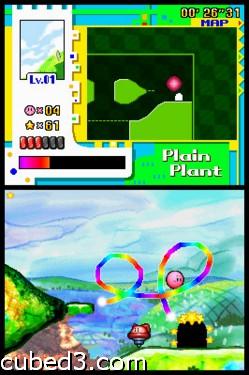
Cubed3 Rating
Exceptional - Gold Award
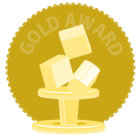
Long awaited by fans, deemed gimmicky by the non-fans, Kirby has come through for one and all and proved that being put on a canvas is no curse if he's involved. This is one of the first really great games on the DS, truly essential. Kirby can come round to my DS to play anytime, legs or no legs.
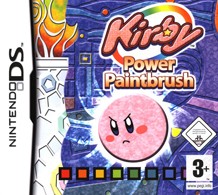
Kirby: Canvas Curse
![]() 9/10
9/10
![]() 9/10
(1 Votes)
9/10
(1 Votes)
 Out now
Out now  Out now
Out now  Out now
Out now  Out now
Out now Comments
Comments are currently disabled

 Sign In
Sign In Game Details
Game Details Subscribe to this topic
Subscribe to this topic Features
Features





 Top
Top

